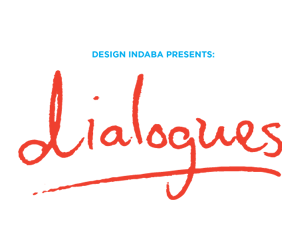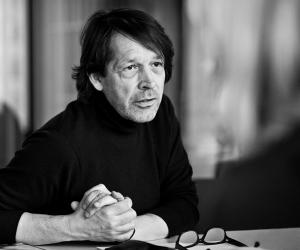Part of the Project
First Published in
He's the one that dunnit. Peter Saville. He's the one that influenced a generation. Including me.
Way back in the new optimism of the 1990s I opened a small clothing store selling skate clothing, brands that captured the mood of the time: FUCT, Label Whore, Blunt, Split. As a business prospect, my little revolutionary broadside wasn't a very bright idea; Pretoria isn't all that interested in rebel consumption. I recall one day having a perplexed debate with my business partner: "I want all our posters and flyers to be catalogued – just like Factory Records." My colleague just stared blankly back at me. I, however, remained intractable on the point; I wanted to emulate the design cool of Factory Records. I wanted to be just like the mythology.
In an age that eulogises rather predictable gods, DJs, actresses and the like, Peter Saville stands out as something of an anomaly: the graphic designer as rock star. I can only think of Neville Brody as another instance of this rare phenomenon. Neither Vaughan Oliver (of 23 Envelope/4AD Records) nor Malcolm Garrett ever really generated anything near the same volume of hagiographic writing that informs the myth of Peter Saville. And what a legend it is.
But let me reign in the hyperbole for a moment. In an interview with Sleazenation, New Order's Peter Hook offered his own revealingly personal, if rather frank insight into Saville. "[He's] an artist and a piss artist who never turns up on time and makes you months late… We'd have the record ready to go and it would be delayed, cos of the sleeve. And where was he? He was fuckin' walking around Paris with some model looking at perfume bottle shapes, the twat."
What amazes me most about this outburst is the extent to which it feeds the beast, the legend of Peter Saville. And there are many versions of this story: Peter Saville the elegant wastrel, Peter Saville the directionless savant - who scuppered a sure thing with Pentagram.
There is a wonderful moment in Michael Winterbottom's 24-Hour Party People, a film that incidentally features a bit part dedicated to Saville. Tony Wilson is in the toilet of the Russel Club. It is a moment of apocryphal storytelling, and Steve Coogan, playing Factory impresario Tony Wilson, pipes in on the voice over. If it comes to choosing between the truth and the myth, he says, he would always choose the myth. It is a telling revelation, one that probably describes how many of us would like to perceive Peter Saville, like some rare, colourful insect pinned under glass. Stuck.
The truth about Peter Saville is a lot more commonplace, and in a way twice as compelling because of that fact. As he reveals in his interview, he is simply a businessman, or more pointedly, an interpreter, someone with the capability to distil contemporary culture into a meaningful visual format. Sometimes, of course, his job has been noted to offer some darkly comical interludes. His sleeve design for New Order's Blue Monday 12-inch single, widely regarded as a classic, lost Factory Records somewhere between 10p and 50p (depending on who you listen to) on every single sold. It also happened to be the biggest selling 12-inch of all time.
But everyone knows about Factory Records, and indeed much of his design for the music industry. In a series of late-night conversations, I choose to engage Peter Saville on life after "greatness", life after Factory Records. As an interview subject he was eminently loquacious, and had a tendency to thoughtfully mull over his choice of words. Sadly there was also something of a well-practiced narrative to the conversation. This is not unusual. When suffering the public gaze, many famous figures tend to hide themselves behind broad strokes, painting only suggestive outlines of a life.
That said, Peter Saville did have a lot to say, his engaging manner yielding many genuine and surprising insights into the man. That they sit obscured in the sheer volume of his reflections merely confirms an age-old adage: the devil (a creature of myth) resides in the detail.
You've just completed work on the new book (Designed by Peter Saville), as well as being involved in putting together a retrospective exhibition that features much of your design work to date. This must have occasioned its own fair share of contemplation, right?
From a work point of view I've been in a very contemplative frame of mind for the past few years. I gave myself the 1990s to find the conclusive part of my career. I did something in the 1980s that took me somewhere, created a profile for me, created a body of work that I was pleased with. At the end of the 1980s my first incarnation as a studio, Peter Saville Associates, was insolvent. My method of working was anything but guided by profitability, which I managed to get away with for a while, but as I employed more people and the recession kicked in, I couldn't get away with it any longer. Peter Saville Associates came to a conclusion in late 1990, when I joined Pentagram. I was happy with what we had done, proud in fact.
What was it like joining Pentagram?
Pentagram was an introduction to the grown-up world of having a design studio.
It was a company with an integrity, but it was also a different generation to me, philosophically a different generation.
Colin Forbes had imbued Pentagram with a very disciplined operational structure. Pentagram had a spirit of designers cooperative, but it was run in a very disciplined way. By the time I joined in 1990, 18 years after the founding of Pentagram, the senior partners, I think, were more engaged in the business of being Pentagram than with innovation.
There is an innovation sensibility to graphics that is quite hobbyist actually, and you tend to grow out of it. Many senior designers evolve into business people, be it running their own businesses, or in their interaction with business and clients. That's where you end up. And that was the culture of the Pentagram I joined in 1990, with the one exception being Alan Fletcher. Alan was still more interested in getting his brushes out than he was in courting the Financial Times. It was a fantastic experience, almost like a postgraduate course for me.
Would you say your career has been one of resisting growing up and maturing into the roles you outlined?
No, not wilfully. A quick look at my history can suggest that, and I get that from a lot of journalists who do a quick look in, as if I am just some 15-year-old teenager who doesn't want to listen. It's a little bit more complex than that. I was very happy for a year or so at Pentagram to simply learn. When I started out I set up on my own; I had never worked for anybody. I'd had to gather the wisdom of experience myself. I hadn't leant it from anybody.
At Pentagram I found myself in the midst of a diverse and cumulative knowledge base. I had seven successful design partners, some of them working in the latter stages of their careers, and another ten partners at various places around the world. I appreciated it, and I have continued to appreciate it. I must say that all through the 1990s, when I found myself on my own again, almost in every working situation that came up, something that I learnt at Pentagram was there as a resource to call upon. It was fantastic.
What went wrong then?
The problem at Pentagram was that they didn't actually understand me. I particularly had a problem at Pentagram with the older generation. The younger partners were simply filled with petty envy, which I didn't care for. I experienced the same problem after leaving Pentagram, for the next ten years in fact, certain clients and marketing directors of corporations not understanding me. They don't understand anything about me and they don't attempt to learn. I appreciate that in them not understanding me I have to take some responsibility to find the language to make myself understood. But I'll only take half the responsibility. The other half of the responsibility lies with the partner or client to try to understand the person they are working with.
In the years after Pentagram I got particularly frustrated with myself, by my inability to find the language to bridge my instinctive sense of vision about things with business. That frustrated me. In recent years I have come to appreciate advertising agencies. They have managed to find the language, to translate what you see and feel, and to translate that into terms that somebody else can appreciate and understand.
But the senior partners at Pentagram didn't understand where I was coming from.
They didn't like the work I was doing. They told me it wasn't design.
They didn't see the point in it, nor could they see any value in me nurturing fashion clients or luxury brands. Even Alan Fletcher told me while I was at Pentagram that the design for New Order's Republic album was not graphic design. The problem was compounded, at the time, by the fact that I didn't find a way to help them to get it. I didn't do myself any favours either going in late, and not wanting to be a part of the team and so forth.
And it seems Pentagram now values the work I did there, which in retrospect I find upsetting and ironic. David Hillman, in particular, takes a distinctly hypocritical position towards me. I was put forward to be a Royal Designer for Industry this year, and David had it stopped. He lodged a personal objection, which didn't surprise me. What did surprise me was when I then heard that Pentagram now includes my work in presentations. The value of those fashion projects with Nick Knight for Jil Sander and Yohji Yamamoto, and Nick's own book were questioned when I was there. The work was resented because it wasn't profitable. They doubted the value of it then, but it would seem they don't now.
I suppose some of this is reflected in the fact that you are variously credited as being a designer, art director and creative director. Which title, if any, are you most comfortable with?
If you want to get a bit of insight into what I do, there is one piece of press worth reading. Andrew O'Hagan wrote a piece for the London Review of Books, titled "At the Design Museum". I have never met him, nor spoken to him, yet after reading his piece I was astonished. As I read it, I thought, finally someone actually fucking gets it. He quotes me on my influences, on film noir meeting yellow Daytona (a reference to The Long Goodbye). O'Hagan actually understands what I do.
The guys at Pentagram didn't get it, only latterly, resentfully.
Most of the companies I worked for, that I failed to strike a successful relationship with, were the same. For the most part all of them have subsequently gone the way I had suggested. When I advised them they weren't ready to hear it, and for the most part they only found out later.
Following your departure from Pentagram you went to Los Angeles. What was that like?
While I was at Pentagram in 1991 I went to Los Angeles for a six-week period, to work on an identity for a television station. I have to say it was the most forceful impact on my visual sensibility in some years. Being there for six weeks, driving along Sunset, taking a call next to the pool on a cordless phone whilst having breakfast, it is a very different experience to Northern Europe. It is very different to being in London. It had quite an effect, the fabulousness of it, and also the truly awfulness of it. There is something I find fascinating about it, and that I quite like.
After I was asked to leave Pentagram, I went to Los Angeles. After six months I knew in my heart that I couldn't project a future in that place. I remember distinctly driving one Saturday afternoon, through Beverly Hills to Rodeo Drive, to go shopping - again. I remember thinking, I really don't care. I was driving past these big houses asking myself, "Is that what you want one day?" I said no. Once I knew there was nothing there that I wanted, I knew I had to get back - very quickly.
Did your time in Los Angeles help you find the language to bridge the translation barrier, or did it remain a problem into the latter half of the 1990s?
For the most part I learnt the hard way, moving from one nearly successful corporate liaison to another. For example, I fell out with the president of Mandarina Duck, the Italian luggage company, by insisting that the communications programme for the company would have to penetrate the fashion media. I redid the identity in a way that would be acceptable to him, and suggested myself as a positioning consultant for the company. But the president of the company and I just agreed to disagree.
In 1996, he absolutely swore to me that it would be over his dead body that the company be positioned in the fashion media. We had these ongoing debates for a month or so. It was really an Italian generational thing. Fashion to him was la moda, and that if he associated his product with la moda, then it would be out of fashion the next month and that would be the end of Mandarina Duck. I tried to get him to understand that wasn't the case, that the fashion media is the canvas of lifestyle; that was where the product had defined itself, within the context of lifestyle. It wasn't really about fashion but a way of life, which is completely what Mandarina Duck is about.
The sensible, suit version of myself would have just gritted his teeth and persevered. Okay, we can't quite get what we want but we'll compromise. We'll hold on to the client because it's foolish and rash to say bye-bye, we'll compromise and do what the client wants and maybe they'll get it eventually. That's where I disagree. From a business point of view I am my own worst enemy, because I am not motivated by holding onto somebody's bank account. I am motivated by doing something good, part and parcel of which is doing the right thing. I'll be honest and say that there is a high degree of ego in there.
You mean in satisfying yourself?
Yeah. I am motivated by pride. I want to do the right thing, I want to do something great and I want to be associated with doing something great. For me doing something great it doing the right thing - in all ways of understanding the right thing. Timely right, prestigiously right, conceptually right, intellectually right and culturally right. More often than not I can see the right thing. These days, at 48 years of age, if an 18-year-old band is brought to me by some record company, I do not know what the right thing is. I have no idea.
I had to do an interview with a magazine the other day about my show opening in Manchester. They asked what my favourite album covers were. I don't have any favourite album covers. Sure, I have some from when I was a teenager but I am not interested in album covers at the age of 48. I am not interested in them at all. And I don't know whether the album cover for The Darkness is right, or if The Darkness is any good or not - I don't really care. (Incidentally, The Darkness isn't any good.)
When it comes to questions about what to do with Jaguar, what to do with Fortnum & Mason, what to do with Mandarina Duck or the Aramis division of Estée Lauder, I have a pretty good idea what a company should be doing. Very rarely, however, do I meet anybody in the corporate world who senses that I might know, that I might be able to help them. And I don't court it. I don't go through the act of nurturing that kind of business.
In London in particular, it is a very high-energy, high-profile competitive market place for design, brand positioning and marketing. There are a bunch of guys out there with agency backgrounds who really do that stuff, the PowerPoint presentations and all that. It is kind of grubby and it doesn't interest me. It doesn't motivate me. I am motivated by the situation when someone sits down and discusses it with me. I don't need to go off and research for six weeks.
As I have got the hang of things over the last ten years, and also got to the right age to be able to do it, because that's crucial, being of equal age or older than the CEOs, the balance is right. I remember John McConnell saying to me at Pentagram, "Peter, one of the problems is that you don't have any grey hair."
This intuitive sense you speak of, this ability to instinctively know the positioning of a fashion brand or luxury goods item, where does that knowledge derive from?
If you read the press, you always read about what time I get up and so on. In the O'Hagan article, he turns it on its head. He asks if I ever go to sleep. If we call what I do work, if we can call it that, I work very hard. That is all I do. I don't go on holidays, I don't go to parties, I go out at night, but to eat, that's it. My entire life is orientated around a sense of what I am in the midst of.
Do you mean that culturally speaking?
Yes, I am in the midst of my times, and not strictly culturally now. It was cultural when I was young, but now it is more social and political. I am far more political now than ever before. And, for me, it is how these factors influence popular culture. This last year or so, to my feeling, something awful has happened to design, it has got what it wanted. During the 1980s I was part of the last wave of designers who had to coerce industry. Since the last recession, since the mid 1990s, the situation has been entirely different.
The new generation of business doesn't need any help wanting design. They want it big time. I know that my own work in the 1980s played a part in bringing this about, actually quite an interesting part because I got to them young, with something they loved. The New Order covers achieved something that Knoll and IBM never did, they insinuated themselves into the sensibility of young people.
It is very interesting how it happened, it is something I worked out in this reflective period of the book and exhibition. Traditionally design had one or two big clients and museums as patrons. In general, design didn't really affect the mainstream. It was pleasing the converted. By injecting a sense of design into teen pop culture, myself and one or two other people set some benchmarks for a generation or two that they were able to take into their adult lives.
This is unusual for pop culture because, normally, when you return from university at age 22, the Grateful Dead posters and Guns 'n Roses T-shirts had to go. Until the 1980s, you had to shed the ephemera of teen culture like a skin for your adult life, but not if you had a cupboard full of Factory Records. In fact, you wanted your business card to look like that New Order cover, and you wanted your first business to have an identity and a look of a logo.
Are you not somewhat cynical about your achievements then?
Factory endorsed and supported me doing it because we wanted to do something well. We didn't see the people who bought the records as punters or victims, we saw them as an audience, as collectors. I didn't see why pop culture had to be so banal and immature, so tawdry. I thought, why can't this music, which is basically a soundtrack to life, why couldn't it look good. Why can't it look as good as a BMW looks? Why can't it have a cultural content that is comparable to what we have in a gallery or museum? Why not?
It is quite questionable how I went about doing it, but the principle was meant well. It was not done to seduce people into buying the product; that was not the intent. It was more one of respect. We said, we can do this badly or we can do this well. We choose to do it well. But business doesn't operate like that, business is mercenary and ruthless. Business is motivated by profitability. It is not driven by good intent. So, design has become the servant of profitability. And designers are now corporate Casanovas. That's their job, to seduce and coerce the consumer.
You make Factory Records sound as if it were founded on some very utopian, idealistic principles.
I spoke to someone recently who is preparing a book on Factory, and I said I couldn't think of one decision that was ever taken on the basis of profitability, in 14 years. Nobody ever made a decision at Factory based on profitability, that's why it's a legend. That's why it's a brand. This is what frustrates me the most about many of these brands being rolled out now. At some point in the past all these brands were founded on a belief, on somebody actually doing something they believed in, and in doing it well. That is what is at the heart of BMW or Porsche, somebody wanting to make a good car.
Those brands are being shagged to death at the moment.
If it was just about survival it wouldn't be a bad thing, but for the most part it's to hang on to an unrealistic 20% growth target. I see a big problem in this, and I don't believe in it. It's kind of like melting down the family silver each season to make it go a little bit further.



















